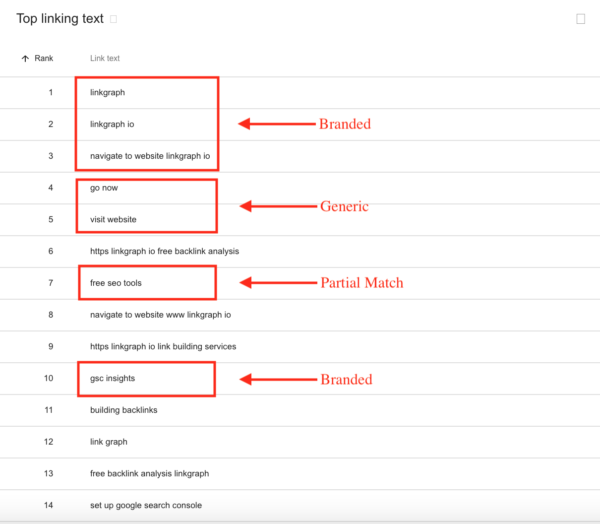Anchors on boats keep the vessels from floating away.
Anchors in your content keep Google (and your readers) from floating away.
As Google crawls your site, it searches for anchor text. Done well, that content signals relevancy and authority. Done poorly, it can sink your content in the eyes of Google (and readers).
What is anchor text?
Anchor text is the visible word or phrase that contains a link to other content. With a click of the phrase, readers can move from their original content destination to another. It could be another website, a different page on the same site, or even a PDF.
In this HTML coding, the anchor text is “Contact us” and linked to an internal page: https://linkgraph.io/learn-how-we-can-grow-your-business:

Good anchor text effectively describes its destination. Relevancy is key because anchor text is meant to identify the content visited with a click.
How does anchor text connect to search rankings?
As Google search engine crawlers scroll your site, the anchor text can indicate the quality of your pages, including:
- Relevancy: Accurately descriptive anchor text indicates to Google the linked content is relevant. This increases the likelihood that Google will associate your web page with that keyword or topic and rank it better in the SERPs for similar keyword phrases.
- Topical breadth: Quality anchor text with internal links communicates to Google crawlers that your site has other useful information. It indicates visitors won’t need to leave your site to get answers to their additional questions.
- Page experience: Misleading anchor text becomes a source of frustration for visitors who click on it and are disappointed to find an irrelevant page. Relevant anchor text shows Google you want to create a quality experience for visitors.
What are the types of anchor text?
Not all anchor text is created equally. Among the options:
- Branded – Contains your company name or terms unique to your domain
- Exact match – Includes the exact keyword you want to rank for
- Partial Match – Contains a variation of the keyword you want to rank for
- Naked URLs – Includes plain URL, such as www.contentmarketinginstitute.com
- Generic – Provides the least amount of context, such as “click here,” “page,” or “read more.”

Using contextual anchor text is one of the most effective means of building trust for your brand. Linking to other helpful, high-quality content with contextual anchor text demonstrates to Google strong relevance signals. Google will also look at the text surrounding the anchor text to understand the relevance, so blogs are often a great place to link back to your primary or pillar pages with context.

High-quality links also help build your credibility among other industry professionals and improve the user experience of your website overall.
Google also strongly emphasizes the importance of diverse anchor text. Repetitive anchor text is indicative of spammy SEO behavior. A combination of branded, exact match, partial match and phrase match links is more natural and shows a well-rounded and informative website.

TIP: Use anchor text in headers and footers that links to the most high-value search-relevant content.
What are the mistakes to avoid?
Google provides some general anchor text creation guidelines. However, many content creators don’t read the 32-page document and make mistakes that can harm their SEO. Here are three of the most common:
1. Irrelevant
One of the primary functions of anchor text is to provide context to users about the link destination. Irrelevant anchor text may garner more clicks initially, but the spammy and misleading technique will not be appreciated by Google or visitors who click on it as Google’s John Mu confirms.
Example for a blog article on company’s recruiting software benefits:
- Bad: Recruiting is a big challenge for HR departments.
- Links to internal article: HR Leaders Should Get Seat at Executive Table
- Better:Recruiting is a big challenge for HR departments.
- Links to internal article: Top 5 Recruiting Problems and How to Fix Them
- Best:Recruiting is a big challenge for HR departments.
- Links to internal article: The Benefits of Automating Your Early Recruiting
2. Too long
More specificity in your anchor text can provide Google with better context. However, long anchor text becomes a problem when it is unclear or overloaded with keywords. While Google details no exact guidelines, it and site visitors prefer descriptive but succinct anchor text.
Example:
- Bad: Learn more about our annual winter sale.
- Better: Learn more about our annual winter sale.
- Best: Learn more about our annual winter sale.
3. Lacks context
Ideally, the anchor text should let readers know what content is possible with a click without any other contextual clues. Generic anchor text, such as “learn more” or “click here,” can’t do that.
Plus, generic anchor text can be considered a missed opportunity to help connect your site pages with relevant industry topics.
Example:
- Bad: Learn more about the topic
- Better: Learn more about the topic in our SEO blog.
- Best: Learn more about anchor text and SEO.
TIP: Google’s crawlers use other indications to identify content topic and relevancy, but linked content is still helpful to both search engines and page visitors.
Anchor text checklist
Keeping up with the do’s and don’ts of anchor text can prove to be a formidable task. To ensure your internal anchor linking is as effective as possible, ask these questions:
- Is it relevant to the destination page?
- Is it relevant to my content?
- Does the surrounding text provide more context?
- Is it stuffed with keywords?
- Is it too generic?
If you answer “yes” to the first three and no to the last two, your anchor text strategy should be in ship shape.
Cover image by Joseph Kalinowski/Content Marketing Institute

